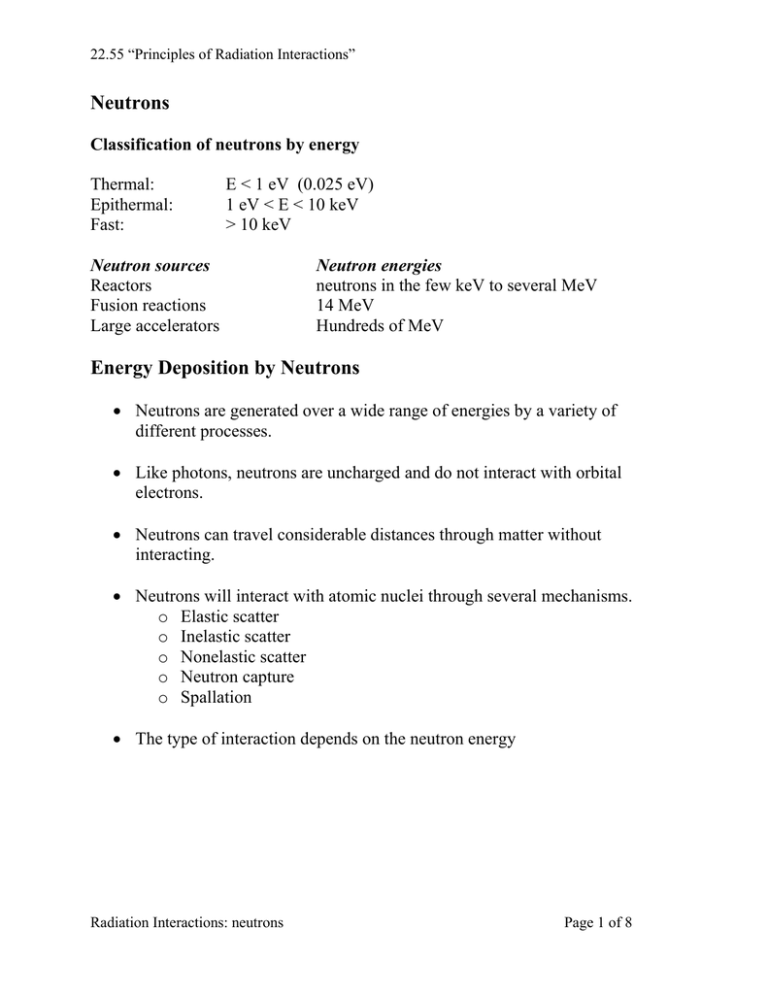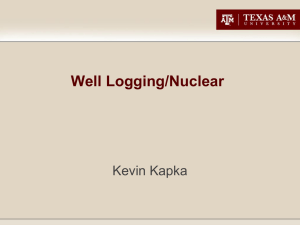Neutrons
advertisement

22.55 “Principles of Radiation Interactions” Neutrons Classification of neutrons by energy Thermal: Epithermal: Fast: E < 1 eV (0.025 eV) 1 eV < E < 10 keV > 10 keV Neutron sources Reactors Fusion reactions Large accelerators Neutron energies neutrons in the few keV to several MeV 14 MeV Hundreds of MeV Energy Deposition by Neutrons • Neutrons are generated over a wide range of energies by a variety of different processes. • Like photons, neutrons are uncharged and do not interact with orbital electrons. • Neutrons can travel considerable distances through matter without interacting. • Neutrons will interact with atomic nuclei through several mechanisms. o Elastic scatter o Inelastic scatter o Nonelastic scatter o Neutron capture o Spallation • The type of interaction depends on the neutron energy Radiation Interactions: neutrons Page 1 of 8 22.55 “Principles of Radiation Interactions” Cross Sections • Because mass attenuation coefficients, µ/ρ (cm2/g) have dimensions of cm2 in the numerator, they have come to be called “cross sections”. • Cross sections do not represent a physical area, but a probability of an interaction. • Cross sections usually expressed in the unit, barn: (10-24 cm2) • The atomic cross sections can be derived from the mass attenuation coefficient. Photons Cross sections are attenuation coefficients, expressed at the atom level (Probability of interaction per atom) NA = atom density (#atoms/cm3) NA = σA = atomic cross section (cm2/atom) ρ A A N0 N0 = 6.02 x 1023 atoms/mole ρ = g/cm3 µ = NAσ A µ= ρ A = g/mole N 0σ A µ N 0σ A = ρ A ⎛ µ ⎞⎛ A ⎞ σ A = ⎜⎜ ⎟⎟⎜⎜ ⎟⎟ ⎝ ρ ⎠⎝ N 0 ⎠ Radiation Interactions: neutrons Page 2 of 8 22.55 “Principles of Radiation Interactions” Neutron Cross Sections Analogous to photons • Neutrons interact by different mechanisms depending on the neutron energy and the material of the absorber o Scattering • elastic • inelastic o Capture • Each energy loss mechanism has a cross section • Neutron cross sections expressed in barns (1 barn = 10-24 cm2). • These cross sections depend on the neutron energy and the absorber Moderation: slowing down of fast neutrons Fast neutrons lose energy in a series of scatter events, mostly elastic scatter. Lower energy neutrons: • scattering continues • probability of capture increases (capture cross sections increase at lower energies) Thermal Neutron Cross Sections Nuclide 10 B 11 B 12 C 1 H 14 N 35 Cl 23 Na 157 Gd 153 Gd Cross section (barns) 3837 0.005 0.0035 0.33 1.70 43.6 0.534 254,000 0.02 Radiation Interactions: neutrons Page 3 of 8 22.55 “Principles of Radiation Interactions” Cross Sections [Image removed due to copyright considerations] Total cross sections for neutrons with hydrogen and carbon as a function of energy • For hydrogen the contributors to the total cross section are elastic scatter (predominant) and neutron capture (σ = 0.33 barns at thermal neutron energy). • For carbon, the cross section is complex due to the different nuclear states possible that may enhance or suppress elastic or inelastic scatter at particular neutron energies. Radiation Interactions: neutrons Page 4 of 8 22.55 “Principles of Radiation Interactions” Neutron Interactions Elastic scatter: The most important process for slowing down of neutrons. • • • • Total kinetic energy is conserved E lost by the neutron is transferred to the recoiling particle. Maximum energy transfer occurs with a head-on collision. Elastic scatter cross sections depend on energy and material. 4mMEn ( M + m) 2 [Image removed due to copyright considerations] Radiation Interactions: neutrons Page 6 of 8 Qmax = 22.55 “Principles of Radiation Interactions” Inelastic scatter • The neutron is absorbed and then re-emitted • The nucleus absorbs some energy internally and is left in an excited state. Eγ = ~ 10 MeV e.g., 14N(n,n′)14N • De-excitation emits a gamma ray. • In tissue, inelastic scatter reactions can occur in carbon, nitrogen and oxygen. Nonelastic scatter • Differs from inelastic scattering in that a secondary particle that is not a neutron is emitted after the capture of the initial neutron. Eγ = 1.75 MeV e.g., 12C(n,α)9Be • Energy is transferred to the tissue by the alpha particle and the de-excitation gamma ray. Neutron capture • Same as nonelastic scatter, but by definition, neutron capture occurs only at low neutron energies (thermal energy range is < 0.025 eV). • Capture leads to the disappearance of the neutron. • Neutron capture accounts for a significant fraction of the energy transferred to tissue by neutrons in the low energy ranges. e.g., 14N(n,p)14C 1 H(n,γ)2H Q = 0.626 MeV Q = 2.2 MeV Ep = 0.58 MeV Eγ = 2.2 MeV • The hydrogen capture reaction is the major contributor to dose in tissue from thermal neutrons. Because the gamma is fairly energetic, the dose to tissue will depend on the volume of tissue irradiated. • Boron Neutron Capture 10 5 B + 01n → 24He + 37Li + 0.48 MeV γ Q = 2.31 MeV Eα = 1.47 MeV ELi = 0.84 MeV Radiation Interactions: neutrons Page 7 of 8 22.55 “Principles of Radiation Interactions” Spallation • In this process, after the neutron is captured, the nucleus fragments into several parts. Only important at neutron energies in excess on 100 MeV. (cross sections are higher at 400-500 MeV). • The dose to tissue comes from the several neutrons and de-excitation gamma rays which are emitted. [Image removed due to copyright considerations] Radiation Interactions: neutrons Page 8 of 8



